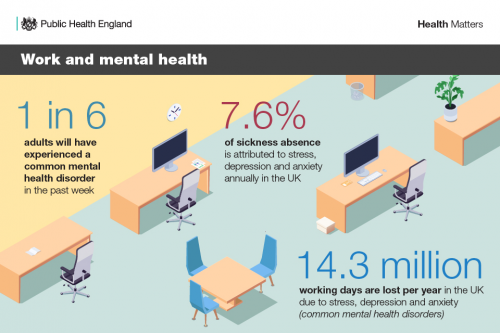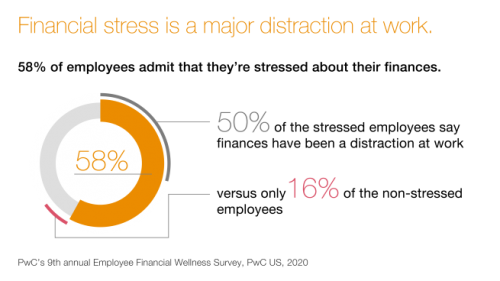Wellbeing in the workplace is the new hot topic of conversation in HR. From wellness workshops to innovative forms of management training, employee health has never been more important to your employer.
Workplace wellbeing schemes aim to empower employees, build strong team relationships and encourage workers to adopt healthy habits in and out of the office.

(Source: GOV.UK)
Studies show that currently, a whopping 61% of corporate workers feel stressed and burned out in their current position, many of them feeling unable to turn to their HR department for physical, emotional and financial support. This has led to increased absenteeism due to depression and anxiety.
As the post-pandemic era of working unfolds, many employers are investing in workplace wellbeing schemes to help combat burnout and lack of motivation while many employees continue to work remotely.
Read on to find out more about the benefits of implementing wellness into your workplace and why HR needs to take the lead.
Why is it important?
It’s no surprise that happy and healthy employees perform better in the workplace. Those with increased mental and physical wellbeing are more likely to be productive in the office, therefore generating a greater value production for the company.
By promoting wellbeing in the workplace, HR teams have the power to improve company culture, reduce stress burnout and improve success rates for the business as a whole.
Here are some of the benefits of prioritizing employee wellness in the workplace:
Return on investment
Many business leaders fail to implement workplace wellbeing schemes into their company, purely on the grounds that they don’t want to spend the money. What many forget is that by investing in your employees, you’re actively investing in your business.
A recent Gallup poll suggested that employees with stronger mental and physical wellness were more engaged at work, stating that there was a 17% increase in productivity of those who were happy and healthy in the office. The findings also revealed that there was a 41% reduction in absenteeism in companies that had an active wellness program, with employees claiming to be less likely to leave their current employer.
With higher productivity rates and a decrease in wellness-based absences, it’s no surprise that companies are profiting from adopting wellbeing practices into their HR departments.
Company culture
A healthy team is a happy team. By introducing wellness programs and team-building exercises into your company culture, HR will not only see a boost in staff morale but an influx in skill sharing and combined success.
A company culture that fosters and supports its employees is more likely to have a stronger workforce that is less likely to leave employment. Perkbox research found that 36% of UK corporate workers leave their position in less than a year when they feel unsupported, meaning that it is imperative that HR begins to take action.
Employees that feel valued are not only likely to invest their value into a company over a long period of time but are more likely to positively review it online. In a digitally dominated era, positive online feedback improves company recruitment and online presence.
Why HR needs to take the lead
As the backbone of the company, it’s often up to HR to engage in employee wellness and take active steps to improve the company’s working culture.
According to Salesforce, employees who feel as if their voice is heard are 4.6 times more likely to perform their best work.
To achieve success, CIPD states that the ball is in the court of the HR team. As pioneers for employee wellness, it’s up to HR to conduct regular wellness audits, provide support and ensure that the working environment both in and out of the office upholds a wellbeing culture.
Of course, management needs to be a part of this process, but ultimately it’s up to HR professionals to guide a fostered relationship between employer and employee for guaranteed success.
How to create a successful wellbeing program
There are many factors that go into creating a successful wellbeing program for HR. However, it can be easier to break these down into two umbrella components of physical and emotional wellbeing.
Physical wellbeing
87% of people in a recent Workforce survey said they consider the company’s physical wellness benefits when choosing their employer.
By offering strong physical wellness incentives such as healthy snacks in the office, gym memberships and regular health clinics, businesses are more likely to attract higher rates of recruitment.
Healthy eating plans have also become a popular HR wellbeing strategy, with over 70% of UK employers now dedicating time to encouraging healthy eating behaviours amongst their staff.
This said, newly remote workers have now become a priority when adapting physical wellbeing programs to accommodate the fallout of Covid-19.
Another important facet to consider is employee eye health. According to statistics, there are more than 2.2 billion people around the world that have some form of blindness or vision impairment while 75% of adults need some form of vision correction.
The chances are that at least some of your employees fall into this category. For those who’re required to work in front of the screen for the majority of their working day, another essential addition to the employee’s workplace would be to purchase monitors that are harmless to the eyes – these generally come with a blue light filter or computer glasses that can help relieve eye strain.
If you are looking to implement a remote wellbeing scheme into your company, maintaining health is the first step towards a healthier working environment.
Emotional wellbeing
One of the simplest yet effective ways to monitor and support college wellness is for HR to introduce consistent feedback and audit opportunities into their company wellbeing programmes. 89% of HR leaders suggest that regular peer feedback and check-ins are key to maintaining positive emotional wellbeing amongst the team.
The responsibility doesn’t end there, though. To further improve the company culture, it’s important to take employee feedback on board and use it to personalise wellbeing workshops and team-building exercises to eliminate the issues raised.
Our psychological wellbeing can also be affected by our financial background. Although it is not a company’s obligation to support its employee’s financial challenges, many larger businesses are now introducing financial advisory services to their HR departments to further support their staff.

(Source: PwC)
As suggested by the graph above, financial stress is a major distraction at work, affecting both the mental health and productivity of employees. In order to combat this, many HR benefits packages now include discount rewards schemes and financial planning classes that give employees an incentive to stay with the company and manage their money effectively.
In conclusion
Workplace wellbeing continues to be a constantly evolving responsibility for leading HR professionals, proving to be a real game-changer in terms of company success.
In a recent study, 61% of employees said that they have made healthier lifestyle choices in response to their HR’s company wellness program. By simply adopting wellness techniques into your company culture, staff are more likely to feel valued and respected, driving value production and innovation as the business grows.
In post-pandemic working conditions, employee health is at the center of all HR conversations. Whether it be physical or emotional, employee wellness matters and will be the driving force for a successful corporate future.
Interesting Related Articles: “Show Your Appreciation for Your Employees After a Difficult Year“

